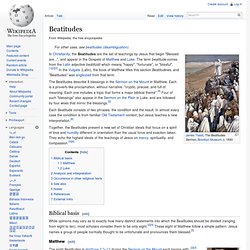

Sermon on the Mount. The Sermon on the Mount (anglicized from the Matthean Vulgate Latin section title: Sermo in monte) is a collection of sayings and teachings of Jesus, which emphasizes his moral teaching found in the Gospel of Matthew (chapters 5, 6 and 7).[1] It is the first of the Five Discourses of Matthew and takes place relatively early in the Ministry of Jesus after he has been baptized by John the Baptist and preached in Galilee.

The Sermon is the longest piece of teaching from Jesus in the New Testament, and has been one of the most widely quoted elements of the Canonical Gospels.[2] It includes some of the best known teachings of Jesus, such as the Beatitudes, and the widely recited Lord's Prayer. To most believers in Jesus, the Sermon on the Mount contains the central tenets of Christian discipleship.[2] Background and setting[edit] Lord's Prayer. The context of the prayer in Matthew is a discourse deploring people who pray ostentatiously: Jesus instructs his listeners to pray in the manner prescribed in the prayer.

Taking into account its structure, flow of subject matter and emphases, one interpretation[1] of the Lord's Prayer is as a guideline on how to pray rather than something to be learned and repeated by rote. The New Testament records Jesus and his disciples praying on several occasions, but never this specific prayer, so the application and understanding of the prayer during the ministry of Jesus is unknown. In biblical criticism, the prayer's absence in the Gospel of Mark together with its occurrence in Matthew and Luke has caused scholars who accept the two-source hypothesis (against other document hypotheses) to conclude that it is probably a logion original to Q.[2] Text[edit] Greek and Latin versions[edit] Given here is the Greek text of Matthew 6:9–13 and the Latin text used in the Catholic Latin liturgy.
Beatitudes. In Christianity, the Beatitudes are the set of teachings by Jesus that begin "Blessed are...

", and appear in the Gospels of Matthew and Luke. The term beatitude comes from the Latin adjective beātitūdō which means "happy", "fortunate", or "blissful".[1][2][3] In the Vulgate (Latin), the book of Matthew titles this section Beatitudines, and "Beatitudes" was anglicized from that term. The Beatitudes describe 8 blessings in the Sermon on the Mount in Matthew. Each Beatitude consists of two phrases: the condition and the result. Together, the Beatitudes present a new set of Christian ideals that focus on a spirit of love and humility different in orientation than the usual force and exaction taken. Biblical basis[edit] Matthew[edit] Plaque of the Eight beatitudes, St. Blessed are.. In verses 5:11-12, the eight Beatitudes are followed by what is often viewed as a commentary—a further clarification of the eighth one with specific application being made to the disciples.
R. Luke[edit] Notes[edit] Five Discourses of Matthew. In Christianity, the term Five Discourses of Matthew refers to five specific discourses by Jesus within the Gospel of Matthew.[1][2] The five discourses are: the Sermon on the Mount, the Missionary Discourse, the Parabolic Discourse, the Discourse on the Church and the Discourse on End Times.

Each of the discourses has a shorter parallel in the Gospel of Mark or the Gospel of Luke.[3] Structure[edit] Biblical scholars generally agree on the existence of the five separate discourses, although discussions and differences of opinion exist about specific details.[4][5] Beginning with B. Blomberg showed how the five-discourse structure can be used to relate the top-level structure of Matthew with Mark, Luke and John.[2] In his mapping Chapter 13 of Matthew is its center, as is Mark 8:30 and the beginning of Chapter 12 of John.